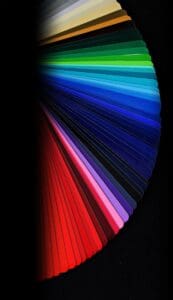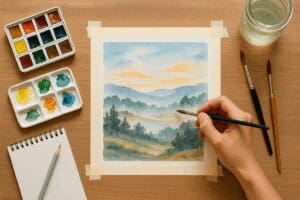Welcome to Irish Artmart! If you’re here, you’re likely passionate about drawing and looking to refine your techniques or learn new ones. Today, we’ll dive into some fundamental drawing techniques that are essential for any artist’s toolkit: Hatching, Cross-Hatching, Stippling, and Contour Drawing. These methods can add depth, texture, and dynamism to your artwork, elevating it from simple sketches to intricate masterpieces.
Hatching
What is Hatching?
Hatching is a technique that uses closely spaced parallel lines to create shading and texture in a drawing. This method is especially effective for indicating light and shadow, giving a three-dimensional feel to a two-dimensional surface.
How to Hatch
- Start Light: Begin with a light hand to ensure you can build up the darkness gradually.
- Parallel Lines: Draw lines that are parallel to each other. The closer the lines, the darker the area will appear.
- Direction Matters: Pay attention to the direction of your lines. For instance, curved lines can suggest the contours of an object, enhancing the sense of form.
Practical Applications
Hatching can be used in various forms of art, from detailed portraits to landscapes. It’s particularly useful in pen and ink drawings where shading options are limited.
Resources for Hatching
Social Media Hashtags
#ArtTechniques #Hatching #DrawingTips #IrishArtmart #ArtCommunity
SEO Keywords
Hatching technique, shading with hatching, hatching drawing tutorial, drawing techniques, beginner drawing tips
Cross-Hatching
What is Cross-Hatching?
Cross-Hatching involves drawing intersecting sets of parallel lines. This method builds on hatching by adding a second layer of lines, typically at an angle to the first, to create a more complex and deeper shading effect.
How to Cross-Hatch
- Layer Your Lines: Start with a basic layer of hatching.
- Add Angled Lines: Draw a second set of lines over the first at a different angle (typically perpendicular).
- Build Gradually: Continue adding layers of lines at various angles to deepen the shading.
Practical Applications
Cross-hatching is ideal for creating a wide range of tonal values and textures. It’s frequently used in detailed illustrations, engravings, and in works that aim for a high degree of realism.
Resources for Cross-Hatching
Social Media Hashtags
#CrossHatching #ArtTutorials #DrawingSkills #IrishArtmart #ArtistTips
SEO Keywords
Cross-hatching tutorial, cross-hatching shading, drawing with cross-hatching, advanced drawing techniques, shading methods
Stippling
What is Stippling?
Stippling uses small dots to create shading and texture. By varying the density and distribution of the dots, you can create gradients and intricate details.
How to Stipple
- Use a Fine Tip: A pen with a fine tip is best for stippling to ensure control over the size and placement of dots.
- Control Your Density: Place dots closer together for darker areas and farther apart for lighter areas.
- Be Patient: Stippling is a time-consuming process that requires patience and precision.
Practical Applications
Stippling is commonly used in ink drawings and pointillism paintings. It’s great for creating detailed textures and subtle shading.
Resources for Stippling
Social Media Hashtags
#Stippling #DotDrawing #PenAndInk #IrishArtmart #FineArt
SEO Keywords
Stippling art technique, how to stipple, stippling shading, stippling tutorial, pointillism drawing
Contour Drawing
What is Contour Drawing?
Contour drawing focuses on capturing the outline and significant details of a subject, emphasizing the form and structure. This technique involves drawing continuous lines to represent the edges and surface ridges of an object.
How to Draw Contours
- Observe Carefully: Spend time looking at your subject and noting the primary lines that define its shape.
- Continuous Line: Try to draw without lifting your pencil from the paper. This helps in developing hand-eye coordination and capturing the essence of the subject.
- Detail and Simplicity: Start with simple shapes and add details as you progress.
Practical Applications
Contour drawing is excellent for improving observational skills and is often used in the early stages of an artwork to establish the fundamental structure. It’s a staple in life drawing and sketching.
Resources for Contour Drawing
Social Media Hashtags
#ContourDrawing #LineArt #DrawingBasics #IrishArtmart #Sketching
SEO Keywords
Contour drawing technique, continuous line drawing, contour art, observational drawing, drawing basics
Combining Techniques
Understanding and mastering these techniques opens up a world of creative possibilities. Each method offers unique ways to express texture, depth, and detail. Combining them can produce richly layered and visually compelling works of art.
Practice and Experimentation
Try practicing each technique individually before combining them. Start with simple objects and gradually move to more complex subjects. Don’t be afraid to experiment with different media and surfaces.
Tips for Combining Techniques
- Layer Wisely: Use hatching or cross-hatching for broad areas of shading and stippling for detailed textures.
- Mix Media: Combine ink for stippling with graphite for hatching to achieve different effects.
- Balance: Ensure that the different techniques complement each other rather than competing for attention.
Advanced Resources
Social Media Hashtags
#AdvancedDrawing #ArtExperimentation #MixedMedia #IrishArtmart #CreativeTechniques
SEO Keywords
Combining drawing techniques, advanced art methods, mixed media drawing, artistic techniques, art experimentation
Conclusion
Mastering hatching, cross-hatching, stippling, and contour drawing can significantly enhance your artistic skills and open up new avenues for creative expression. These foundational techniques are invaluable whether you’re a beginner or an experienced artist. Practice diligently, experiment boldly, and let your unique artistic voice shine through your work.
For more tips, tutorials, and community support, join us at Irish Artmart. Share your progress on social media using the hashtags provided and connect with fellow artists on their creative journeys.
Happy drawing!
*For collaborations, art features, or inquiries, please contact us at [email protected]. Don’t forget to follow us on Instagram, Facebook, Twitter.
Disclaimer: The views and opinions expressed in this article do not necessarily reflect the official policy or position of Irish Artmart.
Irish Artmart – Your Gateway to Artistic Excellence.




